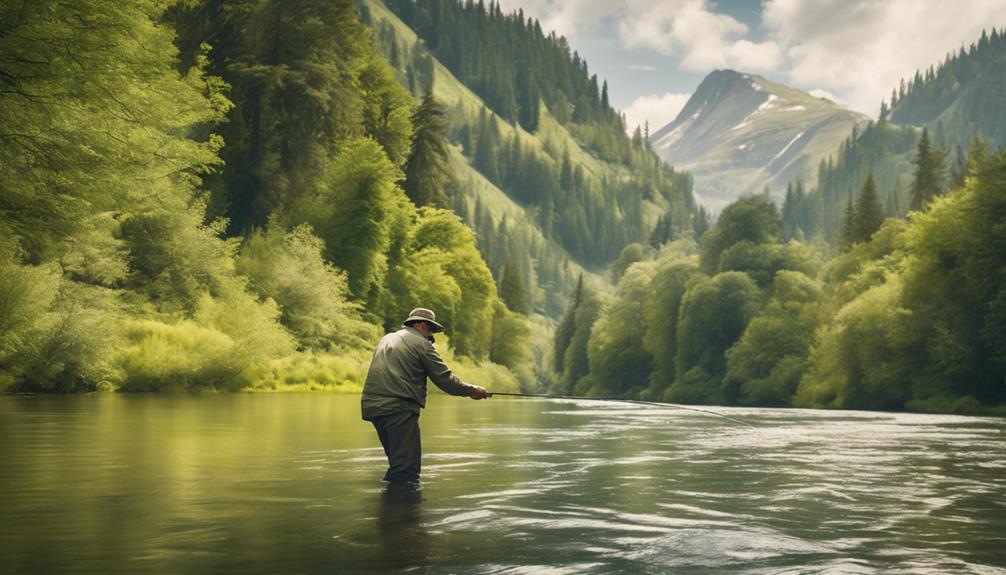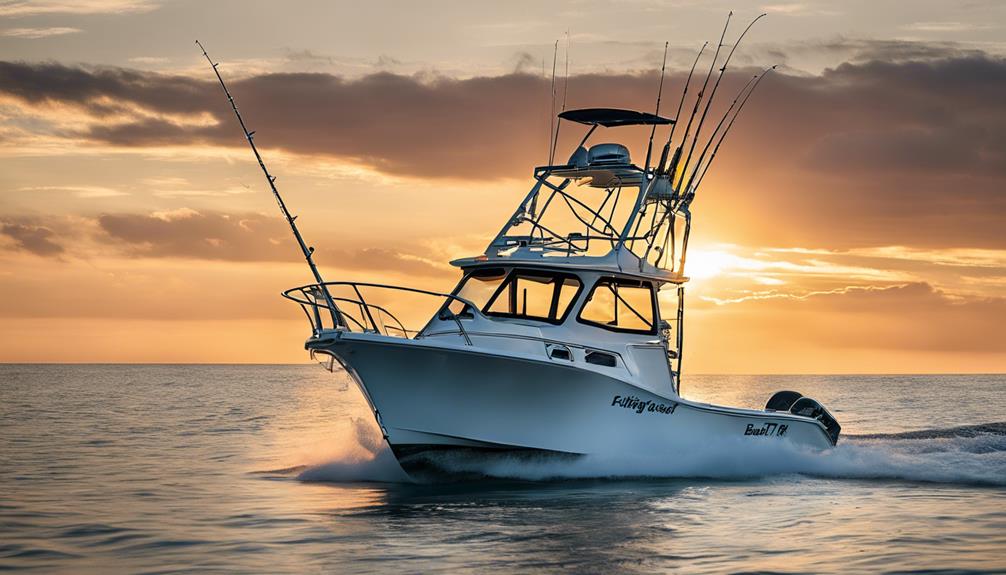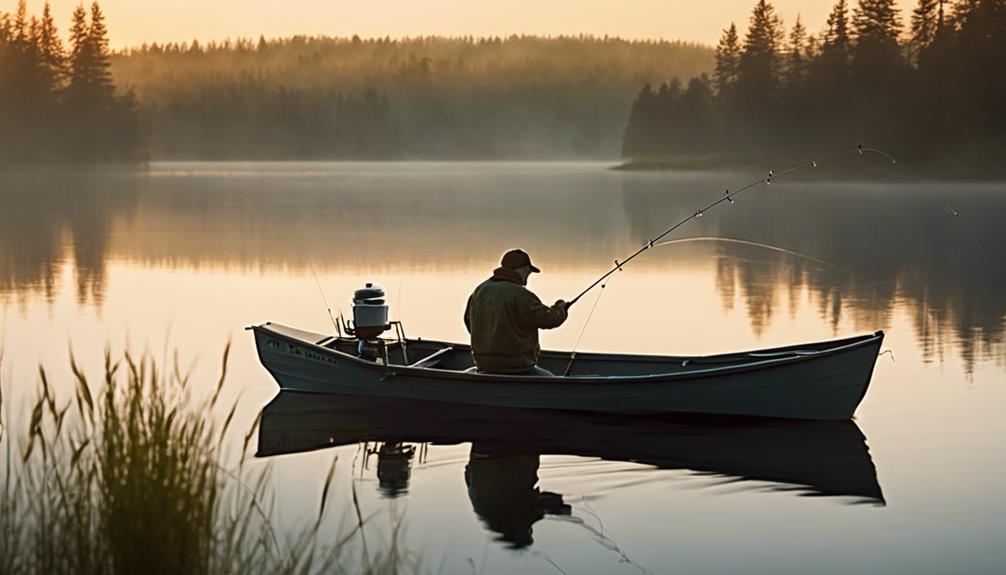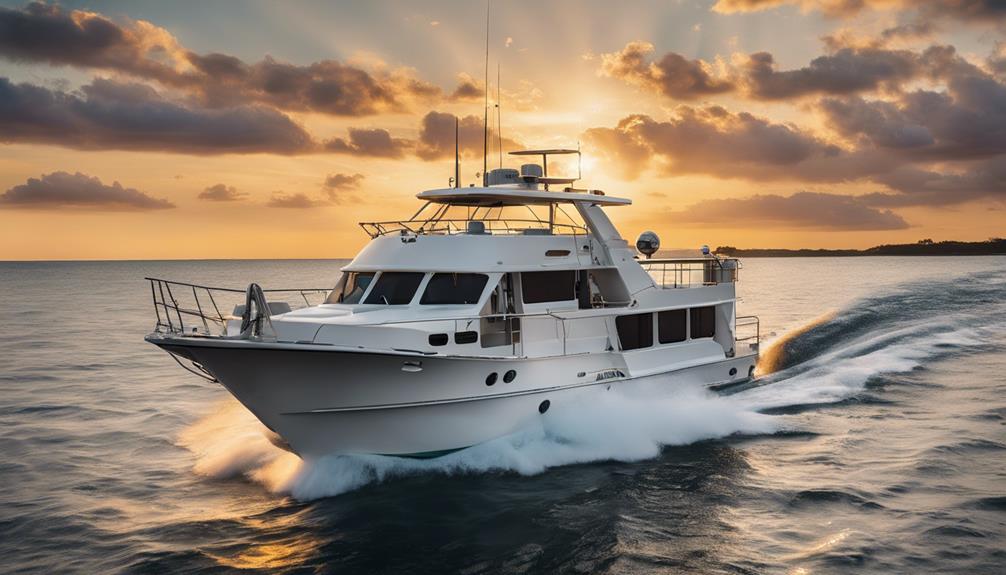Embark on the journey to master salmon angling with a comprehensive guide. Understand migration patterns and respect fishing regulations. Seek prime spots like Kenai River or British Columbia. Equip yourself with a medium-heavy rod, smooth drag reel, and proper gear. Practice precise casting and bait presentation. Learn salmon behavior cues for successful catches. Choose bait wisely based on local species and season. Consider hiring a guide for expert knowledge and equipment. Embrace conservation practices for sustainable salmon populations. Restore habitats and contribute to salmon well-being. This guide will elevate your angling skills and deepen your understanding of salmon fishing.
Types of Salmon Species
When targeting different types of salmon species, it's crucial to understand their distinct characteristics and behaviors for successful angling. Among the various factors to consider, salmon migration patterns play a significant role in determining when and where to fish. Understanding the migration routes of different salmon species can greatly enhance your angling success. For example, Chinook salmon tend to migrate to deeper waters during the warmer months, while Coho salmon often move closer to shore. These nuances in migration behavior can help you strategize your fishing approach accordingly.
Moreover, being well-versed in salmon fishing regulations is paramount to ensure both conservation of the species and adherence to legal requirements. Regulations may vary depending on the specific salmon species, the location of your angling activity, and the time of year. It's essential to stay informed about size restrictions, catch limits, and any seasonal closures that may be in place to protect spawning salmon populations. By following these regulations diligently, you not only contribute to sustainable fishing practices but also avoid potential legal repercussions.
Best Locations for Salmon Fishing
For optimal salmon angling success, identifying prime locations with ideal conditions is crucial in maximizing your fishing opportunities. When it comes to finding the best locations for salmon fishing, consider the following:
- Prime Rivers: Rivers such as the Kenai River in Alaska, the Miramichi River in New Brunswick, and the River Tweed in Scotland are renowned for their salmon populations. These rivers provide the perfect habitat for salmon to spawn and offer anglers a chance to hook into some trophy-sized fish.
- Coastal Hotspots: Coastal areas like the Pacific Northwest in the United States, British Columbia in Canada, and Norway's coastal regions are known for their abundance of salmon. The mixing of saltwater and freshwater in these coastal areas creates nutrient-rich environments that attract large numbers of salmon during their migration.
- River Mouths: Salmon often congregate at river mouths before heading upstream to spawn. Fishing near river mouths like the mouth of the Columbia River in Oregon or the Tay Estuary in Scotland can increase your chances of landing a prized salmon.
- Alaskan Wilderness: Remote locations in Alaska, such as Bristol Bay or the Kodiak Island region, offer unparalleled salmon fishing experiences. These untouched wilderness areas provide not only a serene angling environment but also some of the best salmon fishing opportunities in the world.
Essential Gear and Equipment
To optimize your salmon angling success in these prime locations, ensuring you have the appropriate gear and equipment is paramount. When it comes to rod selection, opt for a medium to medium-heavy rod around 8.5 to 10 feet long for optimal control and casting distance. Pair this with a high-quality reel that offers smooth drag systems and good line capacity. Reel options vary, with spinning reels being popular for their ease of use, while baitcasting reels provide more control over larger fish.
Tackle organization is key to efficiency on the water. Invest in a sturdy tackle box with compartments for different types of lures, hooks, and sinkers. Organizing your tackle ensures quick access and minimizes downtime when changing setups. Additionally, don't overlook the importance of clothing essentials. Dress in layers to combat changing weather conditions, and consider waterproof gear to stay dry and comfortable throughout your angling adventure.
Techniques for Catching Salmon
Utilize precise casting techniques and strategic bait presentation methods to maximize your success in catching salmon during your angling expeditions. When targeting salmon, it's crucial to understand the importance of depth control and effective line handling techniques. Adjust your fishing depth based on the water conditions and the fish migration patterns for the best results. Here are four key techniques to help you enhance your salmon angling skills:
- Casting Accuracy: Salmon can be quite selective, so casting accuracy is essential. Practice casting to specific targets to increase your chances of enticing a bite.
- Retrieve Variation: Experiment with different retrieval speeds and patterns to mimic natural bait movement. This variability can trigger strikes from salmon in different moods.
- Bait Presentation: Pay attention to how your bait appears in the water. Ensure it looks natural and moves convincingly to attract nearby salmon.
- Setting the Hook: When you feel a bite, resist the urge to immediately set the hook. Instead, wait for a moment to ensure the fish has taken the bait fully before setting it firmly.
Understanding Salmon Behavior
Understanding Salmon Behavior involves observing their movements in different water conditions to predict their feeding habits and migration patterns accurately. Salmon have complex spawning habits that vary depending on the species. They typically spawn in the same freshwater streams or rivers where they were born, exhibiting anadromous behavior where they migrate from the ocean to freshwater to reproduce. Observing these migration patterns can be crucial in determining where to find them during specific times of the year.
When it comes to feeding patterns, salmon are known to be opportunistic feeders. They display varying levels of aggression towards different types of prey, which can be influenced by factors such as water temperature, time of day, and available food sources. Understanding their feeding behavior can help anglers choose the right bait and fishing techniques to attract salmon effectively.
Salmon exhibit aggressive behavior, especially when they're in the pre-spawning stage. This aggression can be used to the angler's advantage by presenting lures or flies that trigger a predatory response. By understanding the factors that influence salmon aggression, anglers can adapt their strategies to entice more strikes.
Choosing the Right Bait
Observing the aggressive behavior of salmon can guide anglers in selecting the most effective bait for successful fishing expeditions. When it comes to bait preferences and seasonal variations, understanding what salmon feed on during different times of the year is crucial.
Here are some key points to consider:
- Research Local Baitfish: Investigate the predominant baitfish species in the area and mimic their appearance and behavior when selecting your bait. Matching the hatch can significantly increase your chances of attracting salmon.
- Experiment with Natural Baits: Salmon can be picky, so trying out natural baits like fresh herring, anchovies, or shrimp can sometimes be more effective than artificial lures. Make sure to adjust your bait selection based on the specific preferences of the salmon population in the area.
- Utilize Artificial Lures: While natural baits can be highly successful, artificial lures such as spoons, spinners, and plugs can also be effective in certain situations. These lures offer versatility and can be used to cover more water efficiently.
- Consider Seasonal Variations: Salmon feeding habits can change throughout the year. For example, during spawning seasons, salmon may be more aggressive and territorial, making them more likely to strike at flashy artificial lures. Adapt your bait choice based on the specific behaviors exhibited during different seasons to optimize your chances of a successful catch.
Hiring a Professional Guide
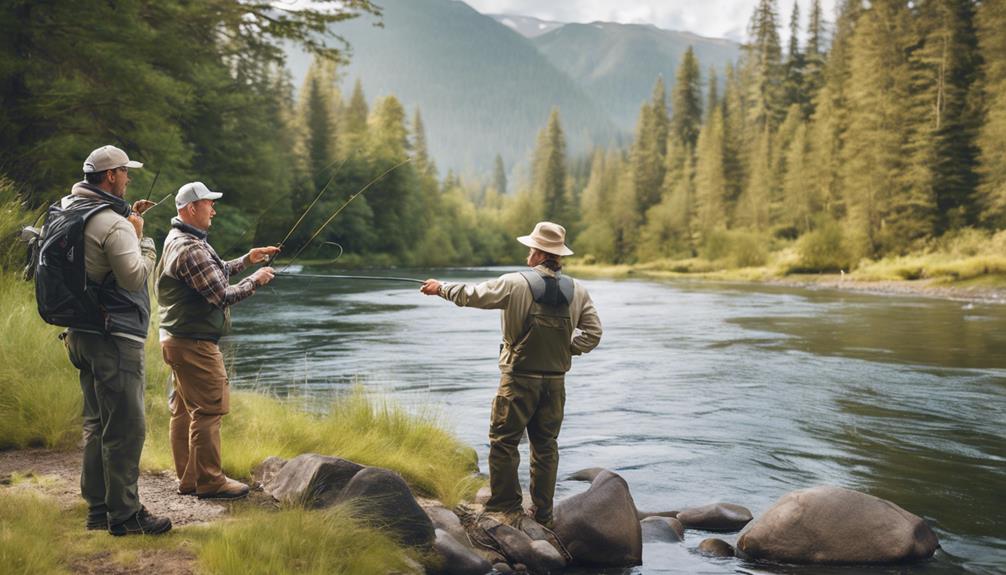
Consider hiring a professional guide when planning your salmon angling expedition to enhance your chances of a successful and rewarding fishing experience. Professional guides offer a wealth of benefits that can significantly improve your angling trip. They possess extensive knowledge of local waters, salmon behavior, and the most effective angling techniques. Guides can save you valuable time by taking you directly to prime fishing spots, maximizing your opportunities to catch salmon. Additionally, they provide all the necessary equipment, saving you the hassle of bringing your own or figuring out what gear to use.
While the cost of hiring a professional guide may seem like an additional expense, the expertise and guidance they provide can make it a worthwhile investment. Prices for guide services vary depending on factors such as location, duration of the trip, and the amenities offered. It's advisable to research and compare different guide services to find one that fits your budget and preferences. Look for guides with a proven track record of success and positive reviews from previous clients to ensure a high-quality experience.
Finding reputable guides can be done through online platforms, local fishing shops, or referrals from other anglers. Make sure to communicate your goals and expectations clearly with the guide to ensure a tailored fishing experience. By enlisting the help of a professional guide, you can increase your chances of a productive salmon angling adventure while learning valuable skills that can benefit your future fishing endeavors.
Conservation Practices for Salmon
To ensure the sustainability of salmon populations, implementing effective conservation practices is imperative in preserving this iconic species for future generations. Conservation efforts play a crucial role in maintaining healthy salmon stocks and ecosystem balance. Here are some key practices to consider:
- Habitat Restoration: Protecting and restoring salmon habitats is essential for their survival. This includes initiatives such as reforestation along riverbanks, removing barriers to fish migration, and controlling pollution levels in water bodies to ensure optimal conditions for salmon to thrive.
- Sustainable Fishing: Adopting sustainable fishing practices helps prevent overexploitation of salmon populations. Techniques such as using circle hooks to reduce deep hooking, avoiding fishing during sensitive spawning periods, and adhering to catch limits contribute to the long-term health of salmon stocks.
- Catch and Release: Engaging in catch and release practices can significantly benefit salmon populations. By carefully handling and releasing caught fish, anglers can help maintain breeding stocks and ensure the continued abundance of salmon in rivers and oceans.
- Population Management: Monitoring and managing salmon populations through data collection, research, and regulations are vital for their conservation. Establishing protected areas, enforcing size limits, and implementing seasonal fishing closures are effective strategies to safeguard salmon populations from decline.
Frequently Asked Questions
Can Salmon Fishing Be Affected by Lunar Phases?
Yes, salmon fishing can be influenced by lunar phases. Lunar cycles affect salmon feeding behavior, with increased activity during certain moon phases.
Additionally, moon phases play a role in salmon spawning patterns, impacting their movement and behavior in the water.
Understanding how lunar phases affect salmon can help anglers optimize their fishing efforts by targeting feeding times and locations based on the moon's influence.
How Do Water Temperatures Impact Salmon Behavior?
Water temperatures play a crucial role in salmon behavior. Fluctuations in temperature influence their feeding patterns, spawning behavior, and migration.
Salmon are sensitive to changes in water temperature, which can trigger them to move to different areas in search of optimal conditions for feeding or reproduction. Understanding how water temperatures impact salmon can help you predict their movements and increase your chances of a successful fishing trip.
What Are Some Common Mistakes to Avoid When Salmon Fishing?
When salmon fishing, avoid common mistakes like using improper equipment and techniques.
Ensure you have the proper gear for the type of salmon you're targeting. Use suitable bait and lures to attract them effectively. Pay attention to your casting technique and presentation to mimic natural movements.
Be mindful of your surroundings and adapt to changing conditions. By avoiding these errors, you can increase your chances of a successful salmon fishing trip.
Is It Possible to Fly Fish for Salmon in All Seasons?
Yes, you can fly fish for salmon in all seasons. Winter fly fishing requires adjusting techniques and gear due to the colder water temperatures, while summer fly fishing offers more flexibility.
Fly fishing techniques like using larger flies in winter and smaller ones in summer are key. Proper gear such as heavier lines for winter and lighter ones for summer can enhance your success when fly fishing for salmon year-round.
Can Using Scents or Attractants Improve Salmon Catch Rates?
Using scents or attractants can improve salmon catch rates significantly.
Scent effectiveness plays a crucial role in attracting salmon to your bait, as they rely on their keen sense of smell to locate food.
Proper application of attractants can enhance this natural behavior by mimicking the scent of their prey, making your bait more appealing.
This strategic use of scents can make a substantial difference in your success when salmon angling.
Conclusion
In conclusion, mastering salmon angling requires a deep understanding of the different species, optimal fishing locations, essential gear and techniques, and bait selection.
By hiring a professional guide and practicing conservation efforts, anglers can enhance their chances of a successful catch while also contributing to the preservation of salmon populations.
With dedication and knowledge, anglers can become proficient in the art of salmon fishing and enjoy a rewarding and sustainable fishing experience.
